Linh Ung means “wishes answered miraculously” in Sino-Vietnamese. And it’s first used in 1841 to name a pagoda in the Marble Mountains by Thanh Thai, the 10th king of the Nguyen Dynasty. Until the 21st century, that is still only Linh Ung Pagoda in Da Nang. In 2004 and 2010, two siblings of it were born. One of the couple sits atop Ba Na Hills (station) and the other is in Son Tra Peninsula. The youngest holds the record “the largest Buddhist temple of Da Nang”. For locals, this trio is the holiest and daily each place draws lots of prayers. Thanks to the stunning locational setting and architecture, all three are famous tourist attractions. There are over 2 million visitors coming to the oldest Linh Ung pagoda in the busiest year. And, it’s 2,5 million and 2,3 million in the case of the laters.
This article provides information about three Linh Ung Pagoda in Da Nang and everything around them. History, architecture, how it looks in reality, transport to get there, tips and advice are covered. Because each is located in a much bigger area, we recommend reading travel guides to “mother attractions” also. There are about the Marble Mountains, Ba Na Hills and Son Tra Mountain (Peninsula).
Read also:

Table of content
- 1 About Three Linh Ung Pagoda in Da Nang
- 2 Linh Ung Pagoda Marble Mountain (aka Non Nuoc Pagoda)
- 3 Linh Ung Pagoda Son Tra Peninsula (aka Linh Ung Bai But Pagoda)
- 4 Linh Ung Pagoda Bana Hills
- 5 Linh Ung Pagoda Tour and Guide
- 6 Linh Ung Pagodas on Google Maps
- 7 Related Posts
- 8 Non Nuoc Beach: The Famous Beach of Da Nang
- 9 How to Get from Da Nang to My Son Sanctuary
- 10 Bach Ma National Park: Hiking, Trekking in Da Nang and Hoi An
- 11 Am Phu Cave Complete Travel Guide
- 12 Asia Park and Sun Wheel in Da Nang (Sun World Da Nang Wonders)
- 13 How to Get to Golden Bridge from Da Nang
- 14 Da Nang Food Specialties: What to Eat in Da Nang
- 15 How to Visit Golden Bridge Vietnam
- 16 Da Nang Shore Excursions: Guided Tours From Tien Sa Port
- 17 Han Market (Cho Han): Where to Shop in Da Nang?
- 18 Da Nang Cathedral (Da Nang Pink Church)
- 19 Things to Do in Ba Na Hills Besides Golden Bridge
- 20 Da Nang Half Day Tours
- 21 Da Nang Private Car and Driver
- 22 Da Nang and Hoi An Itinerary for Visitors Staying Overnight in Hoi An
- 23 Da Nang Things to Do: Guide to What to Do in Da Nang Vietnam
- 24 Da Nang Best Things to Do and Reasons
- 25 How to Get From Hoi An to Da Nang
- 26 Hoi An or Da Nang: Which is Better?
- 27 My Son Sanctuary Tour
- 28 Da Nang Best Area to Stay: Guide to Where to Stay in Da Nang
- 29 Da Nang Cave Tour: Best Underground Activities in Da Nang
- 30 Da Nang Best Time to Visit: Guide to Best Weather in Da Nang
- 31 Da Nang Weather by Month: Guide to Monthly Weather in Da Nang
- 32 What to Do in Da Nang At Night
- 33 Lang Co Vietnam Travel Guide
- 34 What to Do in Da Nang for 3 Days
- 35 My Khe Beach: A Complete Guide to Da Nang’s Best Beach
- 36 Da Nang Day Trips: Guide to Best Day Tours From Da Nang
- 37 Museums in Da Nang
- 38 Linh Ung Pagoda: Trio of Da Nang’s Holiest Mountain Temples
- 39 Da Nang Night Market: A Thing To Do in Da Nang at Night
- 40 Guide to Son Tra Mountain aka Monkey Mountain Vietnam
- 41 Ba Na Hills Tour
- 42 Da Nang Cable Car
- 43 How to Get from Da Nang Airport to Hoi An
- 44 Da Nang to Hoi An: Best Da Nang Airport Transfer and More
- 45 Hai Van Pass Da Nang: Map, Route, Weather, History, Tour
- 46 Da Nang Attractions Guide: What to See in Da Nang Vietnam?
- 47 Lady Buddha Da Nang: The Best of Monkey Mountain Vietnam
- 48 My Son Sanctuary Travel Guide
- 49 Da Nang Museum of Cham Sculpture
- 50 Dragon Bridge Da Nang: The Fire-Breathing Da Nang Bridge
- 51 Ba Na Hills Travel Guide: A First Timer’s Complete Guide
- 52 Golden Bridge Da Nang: A Guide to The Iconic Da Nang Bridge
- 53 Da Nang Bridge: A Guide to Famous Bridges in Da Nang
- 54 Ba Na Hills Cable Car: World Record, Cost, Reschedule, Map
- 55 Da Nang Mountain Temple: Marble Mountain’s Pagodas, More
- 56 Da Nang Caves: Underground World of the Marble Mountains
- 57 The Marble Mountains: Guide to Da Nang’s Iconic Mountain
- 58 Featured Tours and Experieces
- 58.0.1 Golden Bridge and Ba Na Hills Night Tour
- 58.0.2 Golden Hands Bridge Tour In Sunrise or Sunset (1/2 Day)
- 58.0.3 Cam Kim Island Bicycle Tour From Hoi An
- 58.0.4 Cham Island Tour From Hoi An (Group Tour)
- 58.0.5 Cham Island Tour From Da Nang (Group Tour)
- 58.0.6 Hoi An Vegetarian Food Tour
- 58.0.7 Hoi An Evening Walking Food Tour Through Laneways
- 58.0.8 Private Hoi An Basket Boat Tour (Shuttle Bus, Bicycle, Bike)
- 58.0.9 Half-day Am Phu Cave Tour (Private)
- 58.0.10 Hoi An Countryside Tour (Bicycle, Car, Electric Shuttle)
- 58.0.11 Da Nang Tour Package From Singapore
- 58.0.12 Hoi An Evening Tour From Da Nang
- 58.0.13 Hoi An Walking Food Tour Through Laneways
- 58.0.14 My Son Sanctuary and Hoi An Old Town Tour with Thu Bon River Cruise
- 58.0.15 My Son Day Trip From Hoi An including Marble Mountains and Basket Boat
- 58.0.16 Half Day Hoi An City Tour With River Cruise
- 58.0.17 Son Tra Peninsula Tour with Marble Mountains (Private/Small Group)
- 58.0.18 Hue Day Trip From Hoi An with Hai Van Pass, River Cruise & Lunch
- 58.0.19 Hoi An Ancient Town and Countryside Tour (Bests of Hoi An Tour)
- 58.0.20 Hoi An Tour From Da Nang Airport (Private, Optional Lunch)
- 58.0.21 Hoi An Day Trip From Da Nang (Marble Mountains, Basket Boat, Old Town)
- 58.0.22 Da Nang City Tour From Airport (Private, Optional Lunch)
- 58.0.23 Hoi An City Tour with Lantern Class, Lantern Boat, Night Market & Local Food Sampling
- 58.0.24 Marble Mountains, Basket Boat Ride & Hoi An Old Town Walking Tour
- 58.0.25 Marble Mountains & Golden Bridge Day Tour with Buffet Lunch
- 58.0.26 Marble Mountains & Monkey Mountain Tour (Half-day, Private)
- 58.0.27 Private Golden Bridge Sunrise Tour (Half-day, Optional Lunch)
- 58.0.28 Hoi An Ancient Town & Golden Bridge Day Tour (Private/Small Group)
- 58.0.29 My Son Sanctuary & Golden Bridge Day Tour (Private/Small Group)
- 58.0.30 Private My Son Sanctuary Sunrise or Sunset Tour
- 58.0.31 Full Day Hoi An Ancient Town & Countryside Experience With Local
- 58.0.32 Full Day My Son Sanctuary & Hoi An Countryside Tour With Local
- 58.0.33 Full Day Hoi An Ancient Town & Coconut Village Experience
- 58.0.34 Son Tra Peninsula, Marble Mountains and Hoi An City Tour
- 58.0.35 Half-day Marble Mountains Tour from Da Nang or Hoi An
- 58.0.36 Da Nang Cave Tour (Half Day Underground Tour in Da Nang)
- 58.0.37 Hoi An Old Town & Lantern Making Class (Morning Tour, Half-day)
- 58.0.38 Full Day Bests of Da Nang & Hoi An Old Town Walking Tour
- 58.0.39 Full Day My Son Tour From Da Nang with Da Nang City Tour
- 58.0.40 My Son Sanctuary Tour From Hoi An or Da Nang With Local Guide
- 58.0.41 Hue Day Trip from Da Nang or Hoi An via Hai Van Pass with Lunch
- 58.0.42 Full Day Golden Bridge & Ba Na Hills Tour With Buffet Lunch
- 58.0.43 Full Day My Son Sanctuary Tour & Hoi An Old Town With Local
- 58.0.44 Half Day Da Nang Museums and Bridges
- 58.0.45 Da Nang City Discovery
- 58.0.46 Da Nang at a Glance (The Best Half Day Da Nang City Tour)
- 58.0.47 Full-day My Son Tour From Da Nang or Hoi An & Marble Mountains
About Three Linh Ung Pagoda in Da Nang
Why are Three Linh Ung Pagodas in Da Nang?
Each Linh Ung Pagoda in Da Nang is located in a separate mountain and a different direction. The oldest one is in Thuy Son, the largest of the Marble Mountains. It represents “the water” in the Five-elements theory in Asian culture. The rest of the complex symbolizes the wood, fire, metal and earth clockwise. In 2004, the second Linh Ung Pagoda was constructed on a slope of Nui Chua (Bana Hills), the Da Nang’s summit to the west. It faces the city and has a giant Gautama Buddha. In 2020, the next Linh Ung Pagoda came to life, and Son Tra Peninsula to the east was selected to accommodate it. This youngest member of the trio has a huge Lady Buddha (Goddess of Mercy), and faces the city too. Locals believe that all three Linh Ung Pagoda create a spirit triangle to protect them from disasters, like typhoons.
Opening Hours and Best Time to Visit
Each Linh Ung Pagoda in Da Nang has its own opening time. Visitors can visit the ones in the Marble Mountains and the Son Tra Peninsula anytime, but just the surroundings of the Buddha Hall. If would like to see the interior of the Hall, visitors need to come after when the monks wake up and before when the monks go to bed. Unlike Linh Ung Pagoda Marble Mountain, the other doesn’t require an entrance admission in the daytime, from 7 a.m to 5 p.m. Best time to visit these Da Nang’s top attractions is the early morning or late afternoon.
In the case of Linh Ung Pagoda Bana Hills, it’s different. But because of being inside an entertainment complex, visitors need to wait for the greater one opening its doors. To get there, you must buy a ticket and then have a cable car ride, the only way at the moment. First cabins depart at 7:30 a.m and the last tickets are sold at 5 p.m. So, the pagoda often is visited by day trippers from 7:45 a.m to sunset. Cable cars also are operated at night, and the last ride down the mountain is at 9 p.m. For those who plan to see the pagoda in the evening, it’s possible.
Linh Ung Pagoda Entrance Fee
Note: The latest decision made by Da Nang’s leaders indicates that entrance fee of Marble Mountains (Linh Ung Pagoda included) is free until the end of 2022.
Tourists don’t need to pay an entrance fee to visit Linh Ung Pagoda Son Tra Peninsula. Its two older sisters require a ticket. The price is 40,000 VND and 750,000 VND for Linh Ung Pagoda Marble Mountains and Bana Hills respectively. The higher cost includes cable car, sightseeing places, all games of the theme park, outdoor activities and performances. Only Bana Hills’s ticket can be preserved in advance.
Dress Code
Three Linh Ung Pagoda are Buddhist sanctuaries, so visitors and prayers are required to wear respectively. Simple, ensuring that the armpits, navel, and knees are covered and not too much skin is shown. See-through dresses are not recommended. Sarongs are available for free in all places, giving those who don’t know the rules a proper coverage. Before walking in the praying area, visitors need to take off shoes, remove sunglasses, hat or umbrella.
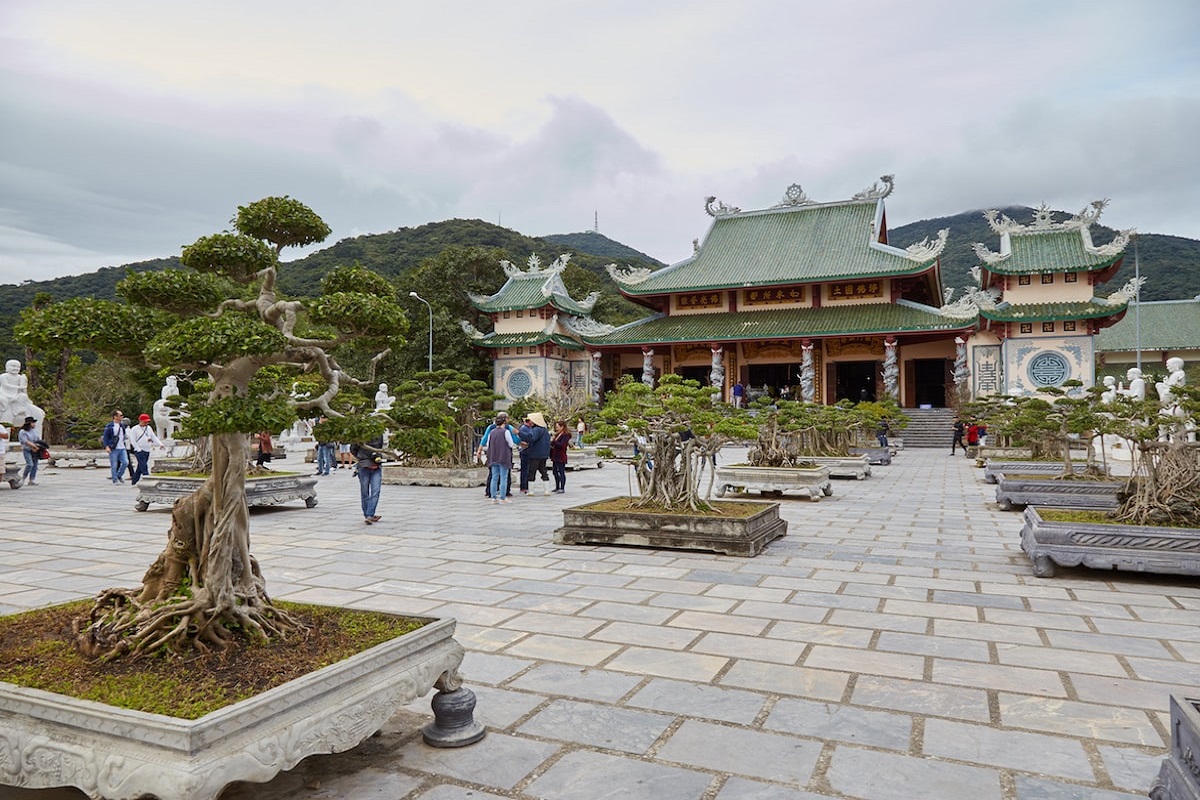
Linh Ung Pagoda Marble Mountain (aka Non Nuoc Pagoda)
History of Linh Ung Pagoda Marble Mountain
Linh Ung pagoda is the oldest Buddhist edifices in the whole of Da Nang. It’s located on a terrace overlooking the sea, luxury hotels and resorts. Established in 18th century, this holy place was built by wood and thatch and by bricks and tiles in 1825. In the same year, Minh Mang king had his first visit to the mountain and renamed it to Ung Chan. He also rewarded it as a national pagoda because of its important role in the Buddhism history of the region. Sadly, a terrible typhoon in 1901 damaged many structures here heavily but was quickly restored by monks and followers. The latest renovation was in 1992.
The name, Linh Ung means “wishes answered miraculously”. It started to be used by Thanh Thai (1891), the 10th king of the Nguyen dynasty. The king changes the former one because the second word Chan is the same as his birth name, a taboo of the time. During the American war, the Vietcong lived in the mountains and were helped a lot by the monks here. 2000 onwards, there are two other pagodas built by the former leader of this sacred site, with the same name, same mountain location but in different directions. The second Linh Ung pagoda is in Ba Na Hills, to the west and the third one is in Son Tra peninsula, to the east. For locals, all three temples create “a spiritual triangle” to protect Da Nang and its inhabitants.
Tour around Linh Ung Pagoda Marble Mountain
Linh Ung Pagoda Marble Mountain owns richly-decorated buildings and graceful Buddha statues, providing interests to look at and take pictures. Local artisans paint on the façade of its main hall by bright colors (white, blue, red and yellow) that harmoniously-blended with surrounding green trees and black wood doors. Pots of the apricot blossom are placed on the front steps, blooming in every new year festival (around February). Yellow flowers of the plant bring delight, nothing more. On the roof, intricate flying dragons and phoenixes are crusted, all mosaiced by hands in typical Nguyen dynasty art. Above, a big banyan tree grows there from 600-years ago and is the hidden meeting place of the Vietcong in the latest war. On the main face, holy animals and flowers in four seasons are also added.
In the Main Hall, the Buddha in Three Times is worshiped in the center. The left represents the past, the middle for present and the future is for the right. Timber name boards given by Thanh Thai when he renamed the pagoda, are visual. Because used for praying and chanting, anybody walking in has to wear respectively. Free sarongs are available for free near the entrance.
If you get to Linh Ung Pagoda by walking, visitors will see the Buddha meditation with dragons in the surroundings, a pond with carps transforming into dragons and a big white Buddha statue behind. The first and last are popular photogenic spots. To the left of the Main Hall, there is the Lady Buddha pavilion, placed in the middle of a pond. Just at a distance to it, stupas containing the ashes of dead monks here are built. In the highest location, the largest one belongs to the leader monk (accessible by a stepway leading to the mountaintop).
How to Get to Linh Ung Pagoda Marble Mountain
Convenient location of the Marble Mountains allows visitors to get to its Linh Ung Pagoda without much difficulty. All local riders know how to reach it and drop off at the nearest entrance. Besides cars, taxis, jeep, and bikes, Da Nang to Hoi An bus is another nice choice. Frequency is 30 mins and the ticket price is only 20,000 VND. Read our guide about transfering between two cities here to know the route. The closest drop-off point is called “Non Nuoc”, and after leaving, passengers need to walk across the boulevard, follow Huyen Tran Cong Chua Rd and come to gate 2 to the left. There are 108 steps leading to the temple. Due to being steep, an elevator is built and costs a small fee to be lifted up. If riding the bikes by yourself, parking lots are near the mouth of Am Phu Cave.


Linh Ung Pagoda Son Tra Peninsula (aka Linh Ung Bai But Pagoda)
History of Linh Ung Pagoda Son Tra Peninsula
Linh Ung Pagoda Son Tra Peninsula is rebuilt on the location of an old Buddhist temple. But when the former one was built is still a secret. According to local fishermans, ther ancestors saw a Buddha statue washed ashore and then a small pagoda was established to worship it. Before setting sail, they came to pray for good weather, safety and bumper catches of fish. The place where people discovered it is called Bai But or “the Buddha beach”. Because of that, the new pagoda is named “Linh Ung Bai But Pagoda”, besides what’s popular today.
The idea about construction of the next Linh Ung Pagoda in Da Nang was initiated by Thich Thien Nguyen monk who led both other sisters. The new one aims to attract more tourists to the peninsula and the city in general. When the suggestion was approved by the city president Nguyen Ba Thanh, lots of people donated money to build this. The works started from 2004, after the Linh Ung Pagoda Bana Hills and finished in 2010. In the inauguration ceremony on 30th July, the monks held rituals and chants to pray for peace, prosperity, and death martyrs who died during the Vietnam wars. According to workers, they saw the glory appearing in the place several times, making it sacred to Buddhism believers.
Buildings in Linh Ung Pagoda Son Tra Peninsula
Linh Ung Pagoda Son Tra Peninsula has many buildings, some of which look monumental and magnificent. The largest construction is the Buddha Hall, facing the south, the best direction in Vietnamese culture. On the stairs leading up to the main doors, the monks place pots of yellow apricot blossoms that bloom every New year festival. Before walking in, visitors can wear free sarong to cover if don’t meet the dress code. In the center of a spacious interior, the Buddha in Three Times is worshiped. Although being newly built, decoration and decoration rules (like Chinese horizontal boards) still continue. This section is a balance between traditional and contemporary architecture.
In the front of the shrines, there is an expansive open yard where two rows of 18 arhat sculptures and lots of bonsai pots are added. Sacred Bodhi fig trees (cay bo de) are planted in the same ground, providing shade to visitors and sacred meaning. Towards the sea, Tam quan, the Three-arched gate stands on the top of a staircase with 2 large dragons crawling on the rails. Here, lots of people stop for photos. If strolling around, it’s possible to see small landscaped gardens, a library, a meeting house, a monk house and a guest house where the female monks stay overnight.
Near the parking lots, visitors have the chance to see a huge 7-storied tower named Xa Loi (“Buddha relic tower”) and an elegant Sleeping Buddha in the front of a three-arched gate. Photography and instant printing service here is available, with a not expensive fee. Looking for middle-aged men, they do. Not far away, scenic outlooks to blue water, white sand of My Khe beach and behind the seafront can be seen. During the sunset, nature’s beauty mesmerizes the viewers.
The Lady Buddha
Standing majestically on a lower ground to Linh Ung Pagoda, the Lady Buddha is the tallest of its kind in Vietnam, 67 meters. She faces the city, to shelter it from disasters. Additionally, the female Buddha is also known as the Goddess of Mercy who “hears the cries of the world”. The prayers coming to her are to seek peace in mind, hope for a better life or a spiritual fulcrum to overcome difficulties. Featuring “Buddha in Buddha”, she houses 17 floors, each filled by 21 Buddhas. The highest storey accommodates the Buddha relic. See details in our travel guide to Lady Buddha.
How to Get to Linh Ung Pagoda Son Tra Peninsula
Linh Ung Pagoda Son Tra Peninsula (and the Lady Buddha) is a top tourist attraction in Da Nang, so getting to it is not hard. All road vehicles are convenient, from car, bus, taxi, motorcycle to bicycle. Walking is feasible and if making the trip by foot, the morning and late afternoon are perfect times. Lots of locals do exercise meanwhile. A taxi ride is just 10 minutes and costs about 150,000 VND. To return to the city, there are many cabbies near parking lots of the pagoda. Riding bikes are other popular ways, with the advantage of low expense and freedom. Parking lots are near the second bend of the cement road to the left of the Coast Road Hoang Sa, and at its end. The fee is free and locals often drop a small amount of money into the box to donate to the monks. One of Da Nang hop on hop off bus’s routes stops at the pagoda.
If planning to reach further and explore the charms of Son Tra mountain (peninsula) by yourself, read our riding guide to know details.

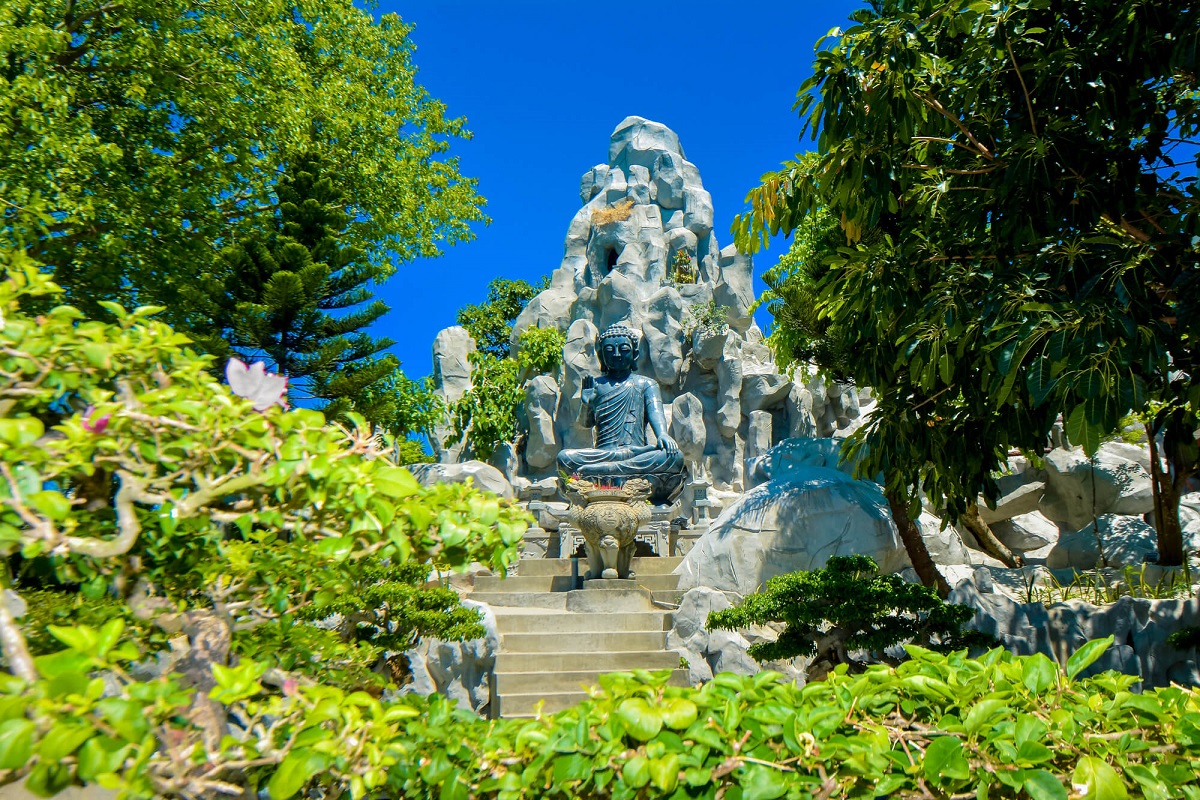
Linh Ung Pagoda Bana Hills
History of Linh Ung Pagoda Bana Hills
Founder of the Linh Ung Pagoda Bana Hills is Thich Thien Nguyen monk who was born in 1945 in a village near the foot of the hills. In 1999, he trekked up the mountain to seek a place to build a pagoda to practice Buddha teachings. Meanwhile, he was the leader monk of the Linh Ung Pagoda Marble Mountain. In a discussion with him, reigning Da Nang city president Nguyen Ba Thanh agreed to add a Buddhist temple in the former Ba Na hill station, for growth of local tourism. However, the specific location couldn’t be determined yet. The presidents recommended a piece of land facing north-west but the monk liked the south-east. So, they draw to pick the final place. In 6th March 2004, Linh Ung Pagoda Bana Hills was inaugurated. It became one of the first tourist attractions in the wider area.
Ba Na Hills Buddha and The Buddha Hall
The Gautama Buddha is the best-known portion of Linh Ung Pagoda Bana Hills. Its height is 27 meters, excluding 6 meters of the lotus base. Around the base, there are paintings depicting stages in the life of the Great Buddha. Sculpted by skillful artists from Non Nuoc marble village (in Da Nang), this supremely elegant statue faces the city. Photography and instant printing services are available here, because it’s one of the Instagrammable spots.
Down the stairs lined with bell-shaped peach blossoms, visitors can see the Buddha Hall. Same to the older one in the Marble Mountains, the Buddha in Three Times is worshipped here. Sarongs for free are available before the doors, to allow visitors without much coverings to use. In the front, the Tree-arched Gate is most photographed. It features a yellow and brown painting, Chinese and Vietnamese letters, dragon and phoenix decorations, and Buddhism flags. There is an immense and incredible landscape behind it, tourists call it “the Heaven gate”. On many days of the year, this place is soaked in dense mist.
How to Get to Linh Ung Pagoda Bana Hills
To get to Linh Ung Pagoda Bana Hills, visitors have to travel by cable car from the foot of the mountain. The nearest landing place is the Ba Na Station, at the end of the first-built cable car. To take its ride, Suoi Mo Station is the only choice. After leaving the cabin, passengers can choose to walk or a funicular transfer. If would like to walk, following the car road and then climbing the stairs to the temple. It takes a longer time when selecting the second way because the train takes passengers to a place quite far. After getting up, keep walking on the paved road down to the gardens and then the Buddha and temple.

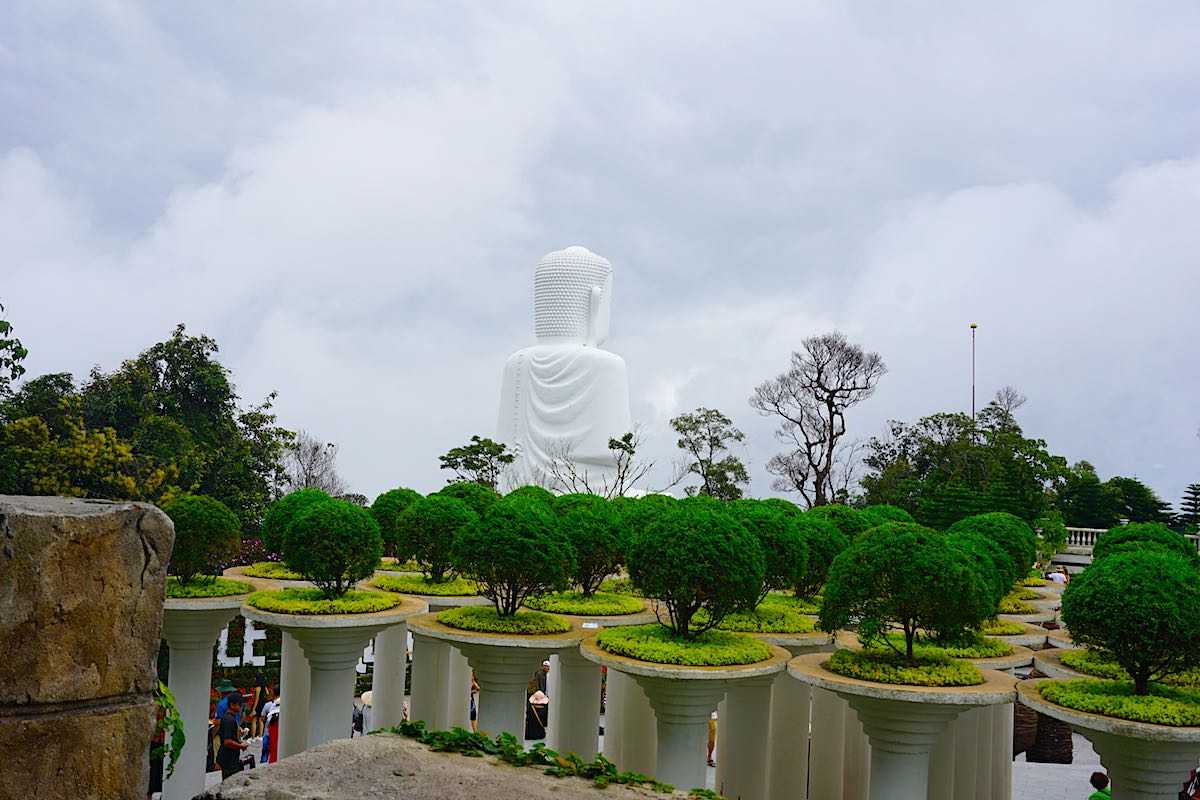
Linh Ung Pagoda Tour and Guide
Tours to Linh Ung Pagoda
All three Linh Ung Pagoda in Da Nang are famous, and so, it’s no surprise that there are many tours recommending visitors to go there. A half-day experience is possible from the city center, no matter which place. But it’s quite rushed when visiting the Ba Na Hill’s, because of the many sights and entertainment. A day trip is more suitable. Read our complete guide to Ba Na Hills Tour for further information. About two other pagodas, find out your best fit in comprehensive travel guides to the Marble Mountains and Son Tra Mountain (Peninsula).
Da Nang Local Guide
A knowledgeable local guide is needed in a visit to Linh Ung Pagoda. Especially if planning to see the one in the Marble Mountains, travelers should book one. The main reason is the rich history of the place, at least from 19th century. In the same mountain, there is another old Buddhist pagoda, its importance is not smaller to the Linh Ung. Caves, grottoes filled by folk religion shrines, scenic viewpoints, cliffs, peaks, hidden tunnels, Buddha sculptures and more are features that draw millions of people yearly. To experience and know the bests, itinerary, recommendations and explanations of the guide are very helpful.
A trip to Bana Hills also requires a guide who designs the most customized plan for yourself. As a part of it, of course, guiding in the Linh Ung Pagoda includes. Because always in organized daily city tours, a stroll around the Son Tra Peninsula can’t be without a guide. Sightseers definitely learn a lot about culture, history and Buddhism before returning to the city. If don’t book any tours, visitors can contact travel agencies, hotels or in social media to find out a dependable guide.
To find a good local guide quickly, you can text us. Our whatsapp number is +84968009827 or email centralvietnamguide@gmail.com.
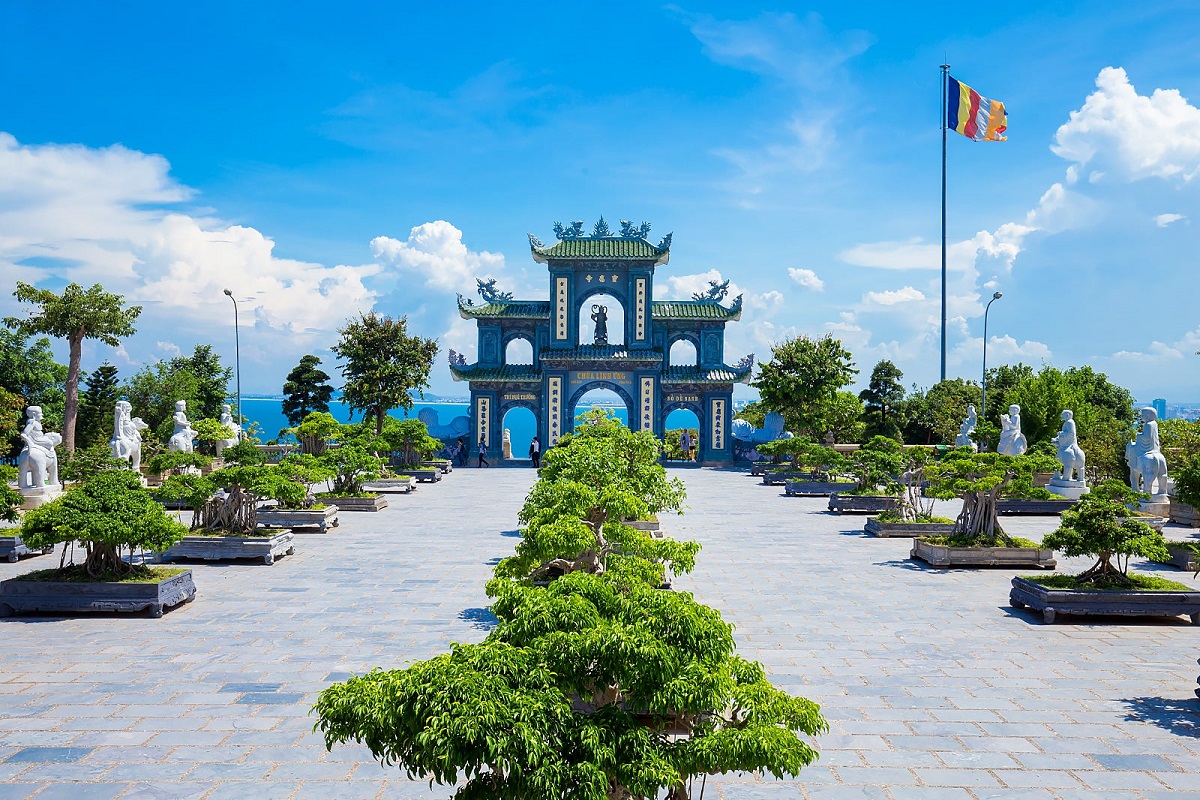
Linh Ung Pagodas on Google Maps
Related Posts
Non Nuoc Beach: The Famous Beach of Da Nang
Besides the Golden hands bridge – a global hit, Da Nang city also has beautiful beaches. If looking for somewhere great to stay and have a slow holiday, Non Nuoc beach should be one of top choices. It’s lengthy, peaceful,
How to Get from Da Nang to My Son Sanctuary
Known as ‘the Angkor Wat of Vietnam’, My Son sanctuary boasts of its sophisticated temples dating back from 4th century. Sadly, in 14th century, it’s abandoned in the forests. Today, this is one of the most important archaeological sites in
Bach Ma National Park: Hiking, Trekking in Da Nang and Hoi An
Two best places for trekking and hiking in and near Da Nang are Son Tra mountain (peninsula) and Bach Ma national park. Which one is better is actually personal because these hot spots have similarities and differences. The same things they
Am Phu Cave Complete Travel Guide
Although in the Marble mountains – the most visited attraction in Da Nang, travelers often miss Am Phu cave. One of reasons is that it’s mentioned much online and not recommended by travel companies (time for the mountain itself is
Asia Park and Sun Wheel in Da Nang (Sun World Da Nang Wonders)
Have you ever seen the wheel of Da Nang? That is the Sun Wheel. It’s a part of greater Asia Park – an amusement park with a heap of fun games and kool rides.Travelers often visit Ba Na Hills when
How to Get to Golden Bridge from Da Nang
The Golden Bridge (aka the Golden Hands Bridge) in Da Nang is a must visit attraction in Vietnam today. Many foreign travelers come to the city, just because they love seeing it and taking some good pictures. Placed in the
Da Nang Food Specialties: What to Eat in Da Nang
Da Nang is known as a food capital of central Vietnam. This city boasts many yummy dishes, prepared by distinctive recipes and some of them are famous all over the country. Someone says that its culinary culture is influenced by
How to Visit Golden Bridge Vietnam
The Golden Hand Bridge of Ba Na hills today is a dream place to visit for many travelers. Since it opened in June 2018, millions of people have set their foot on this amazing bridge. Of course, an uncountable number
Da Nang Shore Excursions: Guided Tours From Tien Sa Port
Da Nang Vietnam today is one of stopovers for many cruises that travel from continent to continent, from country to country. It owns an ideal seaport to moor and it provides travelers awesome spots to visit and activities. The distance
Han Market (Cho Han): Where to Shop in Da Nang?
In the heart of Da Nang, the Han market is a popular place for visitors to buy something to bring home due to the diversity of merchandise. Back to history, it was built by French people as a part of
Da Nang Cathedral (Da Nang Pink Church)
Da Nang became a French protectorate on 3rd October 1888, under the name “Tourane”. By the Han river, the colonists designed a grid of streets with public buildings, a city hall, a market, train, and a church. Over time, these planned
Things to Do in Ba Na Hills Besides Golden Bridge
According to local authorities, 50% of visitors coming to Da Nang and Hoi An visit the Ba Na hills. In other words, that is nearly 10 millions of people. This statistic indicates that the hill station is one of the
Da Nang Half Day Tours
In addition to day trips, travelers have many options of half-day tours in Da Nang to choose from. Not to spend a full day at different places, maybe far from the hotel, it’s more relaxing with one or two attractions
Da Nang Private Car and Driver
Your next holiday destination is Da Nang? You prefer to travel by yourself? Hiring a private car is one of the best options for you to explore with freedom, flexibility and enjoy a personalized itinerary. Somehow, you can save money
Da Nang and Hoi An Itinerary for Visitors Staying Overnight in Hoi An
Da Nang and Hoi An are twin cities in the heart of Central Vietnam. Both are popular tourist destinations for either domestic or international visitors, and share many similarities. Due to smaller, quieter and “three stunners ” – Old town,
Da Nang Things to Do: Guide to What to Do in Da Nang Vietnam
Unquestionably, Da Nang deserves a holiday trip from all types of traveller. Firstly, due to the weather. It has a longer sunny time than the north but less hot than the south. During the wet season, it’s least affected by
Da Nang Best Things to Do and Reasons
Da Nang is the largest tourist center in Central Vietnam. It owns fascinating natural and cultural places that attract both Vietnamese and foreigners. In the busiest year, this city of bridges draws 8,6 millions of visitors. Therefore, it is not
How to Get From Hoi An to Da Nang
Da Nang is the neighbouring city of Hoi An. It's the capital of Central Vietnam and has the most important (busiest) transport hubs of the region, such as airport, train station, bus station, cruise port. No doubt, it’s the gateway
Hoi An or Da Nang: Which is Better?
Da Nang and Hoi An are located in Central Vietnam, with a distance of roughly 30 km. To the north, Da Nang is the capital city of the region, with a contemporary appearance and down south, Hoi An is a
My Son Sanctuary Tour
My Son Sanctuary is a Unesco world heritage site, attracting 450,000 visitors in recent years. It’s the best remains left by the fallen Champa Kingdom which ruled a part of Vietnam from 2nd to 19th centuries. Forgotten by people in nearly a
Da Nang Best Area to Stay: Guide to Where to Stay in Da Nang
In the Central coast, Da Nang has an area of 1,285 km2 and population of 1,134 people, making it become Vietnam’s 4th largest city. It plays an important role in the economy, finance, commerce, transportation, and of course, tourism of the
Da Nang Cave Tour: Best Underground Activities in Da Nang
Different from Hue and Hoi An, Da Nang has limestone caves and grottoes. All of them are within the Marble Mountains (Ngu Hanh Son), a complex of 5 amazing hills formed by a broken dragon egg in the legend. It’s
Da Nang Best Time to Visit: Guide to Best Weather in Da Nang
Da Nang is titled “Asia’s leading festival and event destination” by the World Travel Awards or Vietnam’s greenest city by the WWF. Its reputation comes from amazing natural mountain-to-sea sceneries, richness of local culture and magic transformations in recent decades.
Da Nang Weather by Month: Guide to Monthly Weather in Da Nang
In Central Vietnam, Da Nang has a tropical monsoon climate with two distinct seasons that each starts later than the North 2 months. Because of being shielded by the spectacular Hai Van Pass Range, it’s not much affected by the
What to Do in Da Nang At Night
Between the sunset and midnight, there are many things to do in Da Nang that travelers should know before getting to bed. Thankfully, different styles of traveling, budget or ages can find their own fitted one(s) to get entertained. The
Lang Co Vietnam Travel Guide
Lang Co was a lovely backwater town nestled at the foot of spectacular Hai Van Pass for some decades. Not yet widely known because of the popularity of beaches in Da Nang and Hoi An, it’s a real hidden gem.
What to Do in Da Nang for 3 Days
Da Nang is a lovely coastal city in the middle of 3 Unesco world heritages Hue, Hoi An and My Son Sanctuary. This most worth-living municipality owns a poetic river running through its heart, uniquely-designed bridges, white sandy beaches and
My Khe Beach: A Complete Guide to Da Nang’s Best Beach
Da Nang is a lovely seaside city with many beaches, and the best is My Khe. Located on the eastern coastline, it’s between little-known beaches near the foot of Son Tra Mountain and well-known Non Nuoc Beach lined with luxury
Da Nang Day Trips: Guide to Best Day Tours From Da Nang
Centre and outskirts of Da Nang have incredible attractions where travellers need to spend many hours to get to and fully explore. There are the Ba Na Hills and Golden Bridge on its slope, Hoi An Old Town and its
Museums in Da Nang
Da Nang has many museums where visitors can see and learn a lot. Generally, their exhibitions have different themes, varying in stages of the history, groups of people (communities) having lived in the city, art styles and more. Around the oldest
Linh Ung Pagoda: Trio of Da Nang’s Holiest Mountain Temples
Linh Ung means “wishes answered miraculously” in Sino-Vietnamese. And it’s first used in 1841 to name a pagoda in the Marble Mountains by Thanh Thai, the 10th king of the Nguyen Dynasty. Until the 21st century, that is still only
Da Nang Night Market: A Thing To Do in Da Nang at Night
Different from day markets in Da Nang, night markets are held open-air and on streets where traffic is active during sunny hours. A visit there provides the chance to understand better local products and culture, from food, drink, handcrafted objects
Guide to Son Tra Mountain aka Monkey Mountain Vietnam
From My Khe Beach or Han River promenades, tourists can see a part of the Son Tra Mountain. Although being near the city center, natural forests on its slopes have been preserved well, and it's no surprise that it’s called
Ba Na Hills Tour
Ba Na Hills is one of the best attractions in Da Nang, and the country. Its full name is the Ba Na-Suoi Mo Tourist Area, made from “Ba Na hill station” and “Suoi Mo or the Dream stream”. It was
Da Nang Cable Car
No surprise that now, when travelers make the plan to tour around Vietnam, there are many cable car rides recommended. Some are top things to do in its cities. The aerial journey may be from the plain to top of
How to Get from Da Nang Airport to Hoi An
Located in the city of the same name, Da Nang airport is the nearest airport to Hoi An. So, if travelers want to see an extremely-colorful Lantern festival or try unique Cao lau noodle, a flight ticket to Da Nang
Da Nang to Hoi An: Best Da Nang Airport Transfer and More
If traveling to Hoi An by air, train and cruise ship, visitors will come to Da Nang first and then have a transfer. The largest city of Central Vietnam holds the busiest airport, train station, port and bus stations of
Hai Van Pass Da Nang: Map, Route, Weather, History, Tour
Truong Son or Annamite Range is the most dramatic mountain ridge in Vietnam. When it juts out into the sea, spectacular Hai Van Pass is formed. This amazing sculpture of nature is a high wall where two sides of it
Da Nang Attractions Guide: What to See in Da Nang Vietnam?
Da Nang is the capital city of the Central region, and one of the most attractive destinations to tourists in Vietnam. It’s established by French colonists and called by them as Tourane in 19th century. Now, this coastal municipality is home
Lady Buddha Da Nang: The Best of Monkey Mountain Vietnam
From the East coast, visitors can see an enormous white statue with the mountain backdrop, that is the Lady Buddha Da Nang. Located in the ground of Linh Ung Pagoda, she was sculpted by artisans in Non Nuoc marble village.
My Son Sanctuary Travel Guide
My Son Sanctuary is a complex of Hindu temples and a Unesco world heritage site from 1999. It’s 40 km away from Hoi An and 70 km to the southwest of Da Nang. Thanks to being the religious centre of
Da Nang Museum of Cham Sculpture
Da Nang Museum of Cham Sculpture is a highlight of the Han river waterfront. It’s established by French archaeologists to preserve intricate works of art of Champa kingdom, which ruled the land from 2nd to 14th centuries. Now, it has
Dragon Bridge Da Nang: The Fire-Breathing Da Nang Bridge
Praised to be the world's 30 most unique bridges recently, Dragon Bridge became the new icon for a Han river bridge in Da Nang. Spanning from the 100-years-old Cham Museum, it provides the quickest passage from the airport to My
Ba Na Hills Travel Guide: A First Timer’s Complete Guide
50% of visitors to Da Nang plan to visit Ba Na Hills in their itinerary. It’s larger for first timers who may know about its inspirational Golden Bridge, world-record cable car, huge French Village or theme park. Due to usually
Golden Bridge Da Nang: A Guide to The Iconic Da Nang Bridge
Recently-built but at the present time, the Golden Bridge Da Nang is one of the awaited attractions in Vietnam. On a slope of high foggy mountain, this delicate bridge and its images have inspired countless travelers. In the peak year,
Da Nang Bridge: A Guide to Famous Bridges in Da Nang
Da Nang has many bridges, and some of them are famous nationally and internationally. Before the recently-built Golden Bridge which made a boom in social media, people only knew bridges spanning Han river. In the 1990s, there were no other
Ba Na Hills Cable Car: World Record, Cost, Reschedule, Map
Cable car is one of the first ideas travelers think about Ba Na Hills, a Da Nang’s top attraction. It helps to shorten the time to get to the hills from lower plains, improve visitor safety and reduce air pollution
Da Nang Mountain Temple: Marble Mountain’s Pagodas, More
Da Nang has many mountain temples where handmade architecture, natural sceneries and religious values are combined perfectly. So, travelers will see, enjoy and learn a lot about different things just within a visit, to any of them. Above all, the
Da Nang Caves: Underground World of the Marble Mountains
One of the priceless gifts Mother nature gives to Da Nang is an array of caves and caverns. Almost all are located in the Marble Mountains, a complex of five marble and limestone hills, 10-mins drive from the downtown.
The Marble Mountains: Guide to Da Nang’s Iconic Mountain
Had been an offshore group of islands, geological activities shifted the Marble Mountains to the land some thousands of years before. Today, its marble hills rise suddenly up to over 100 meters from the surrounding delta. All are impressive and how

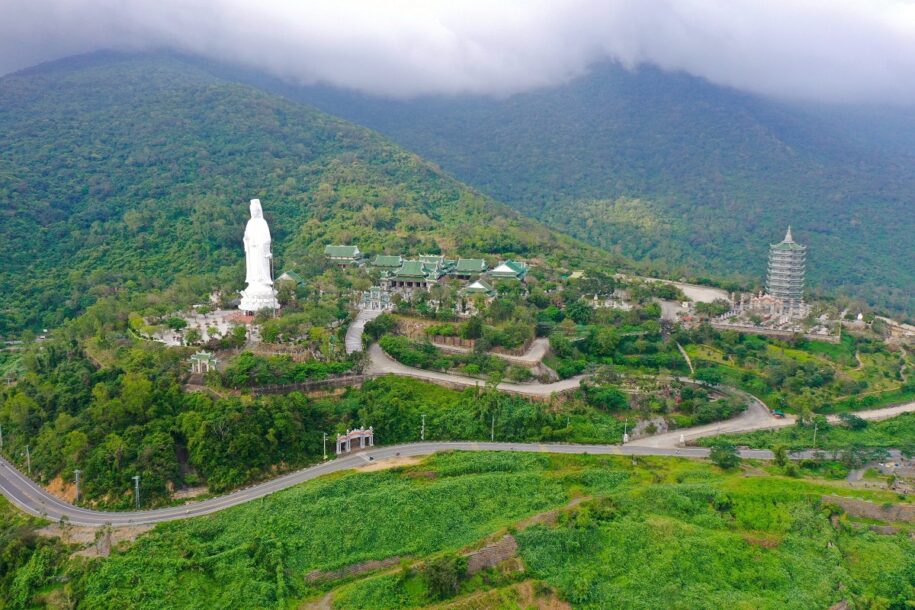





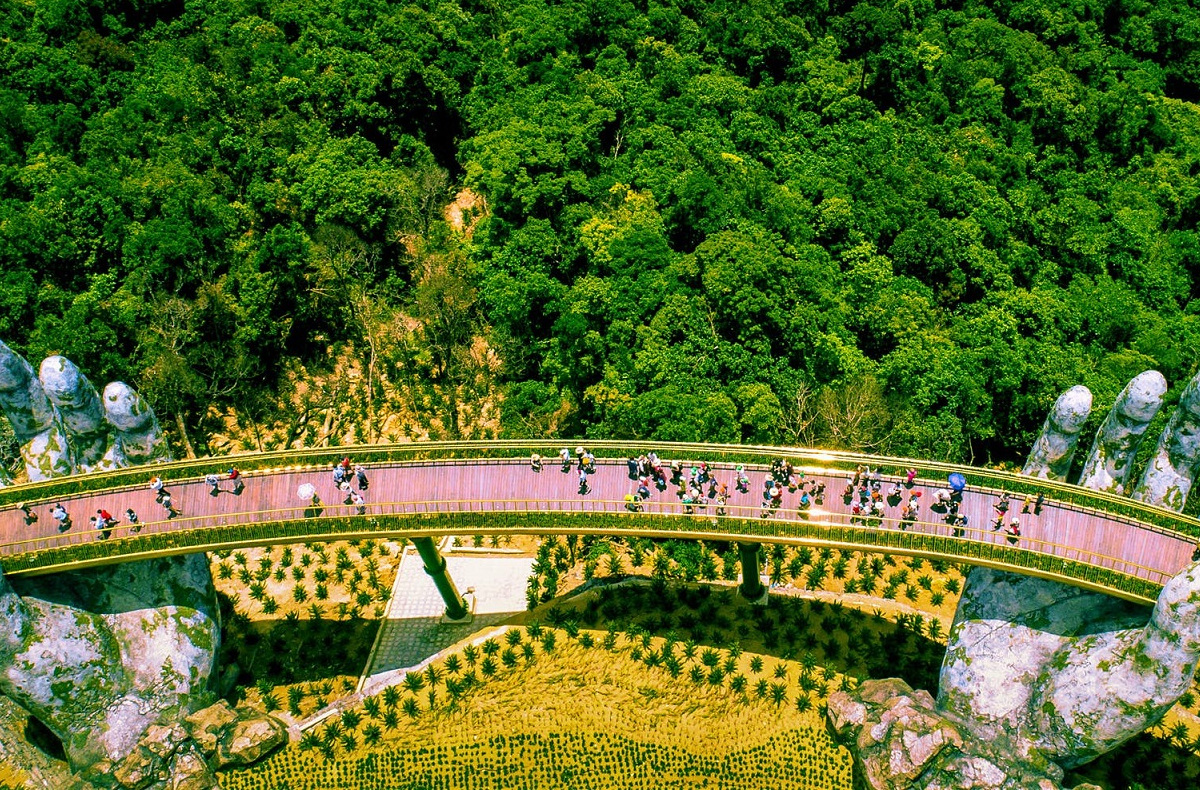






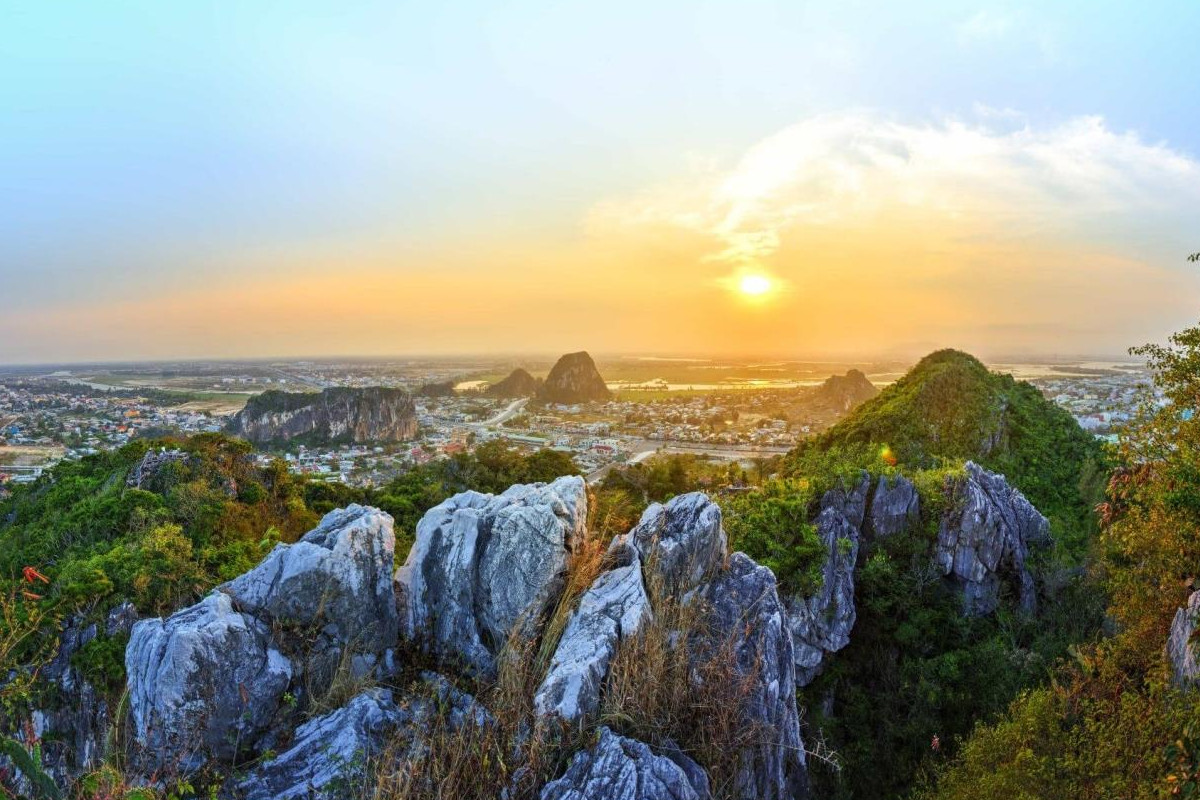




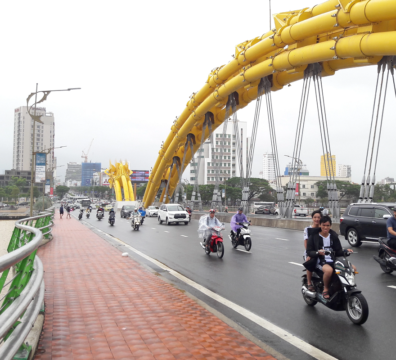



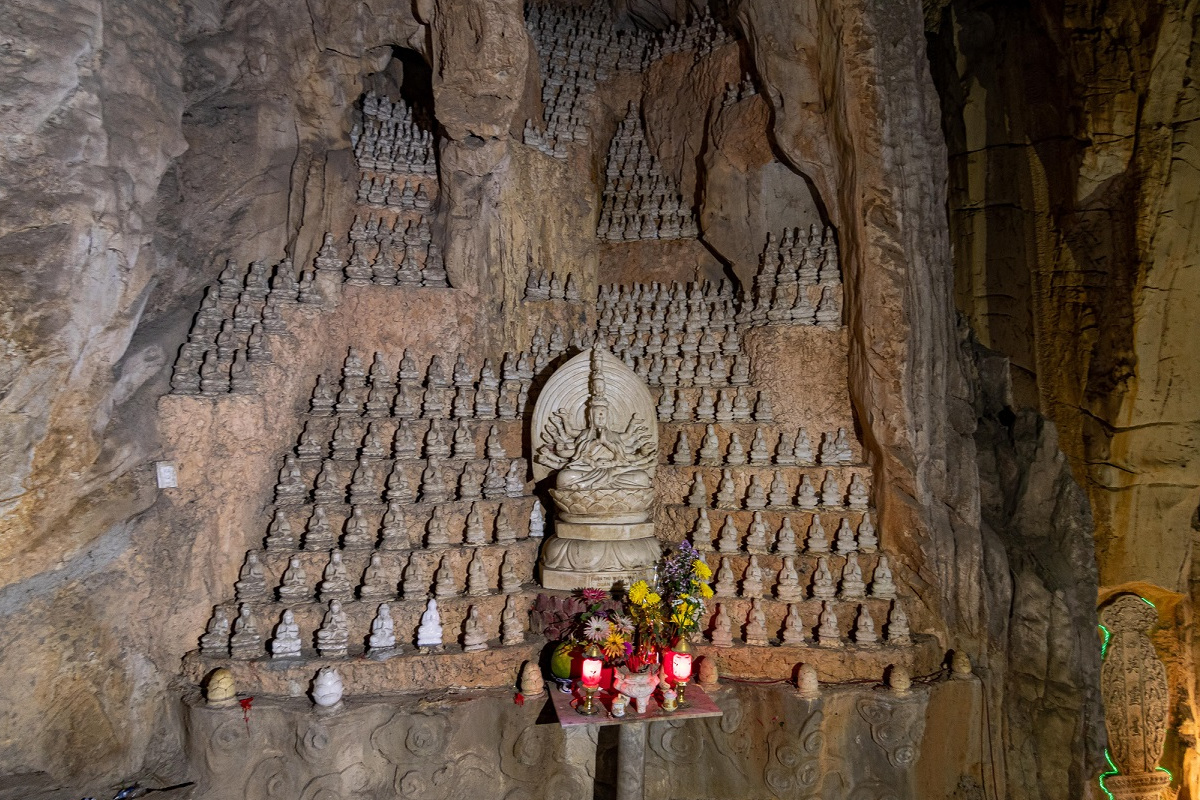









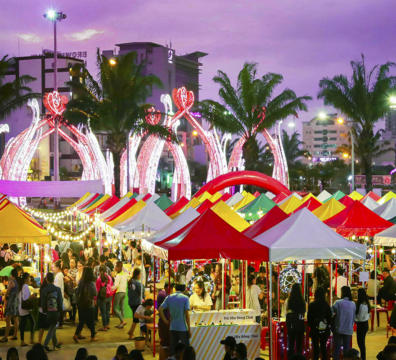
















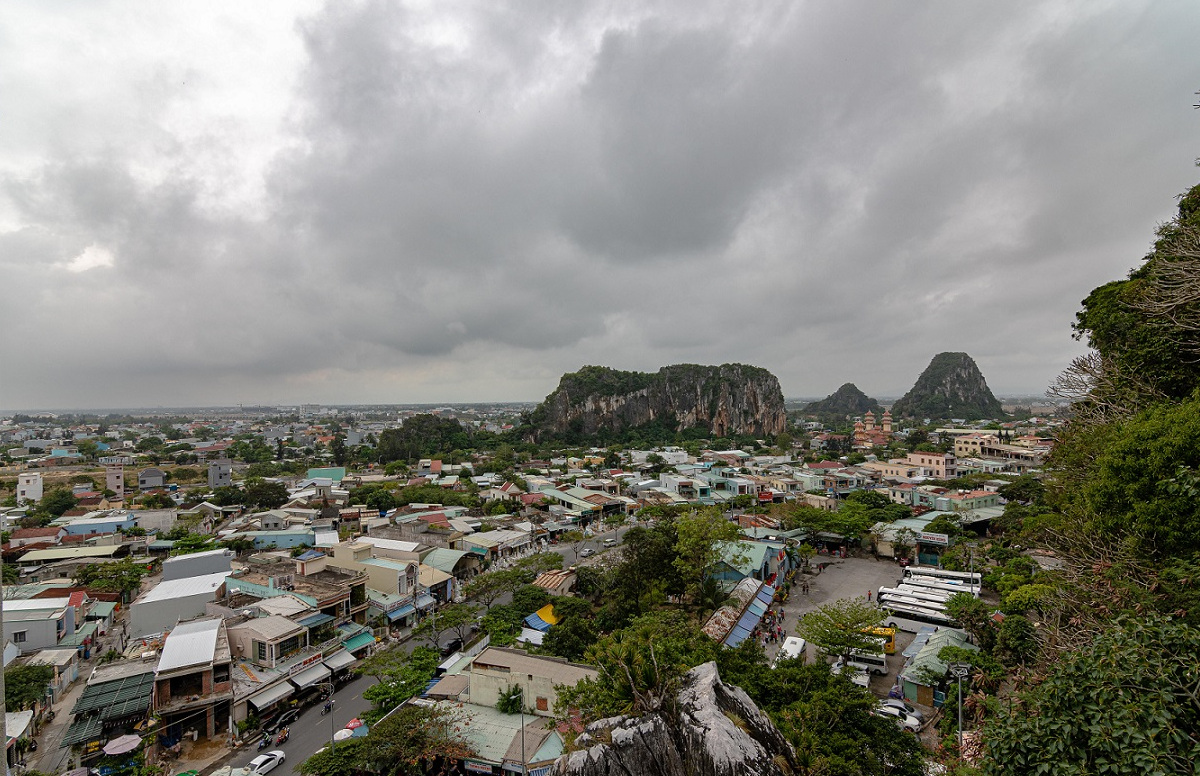

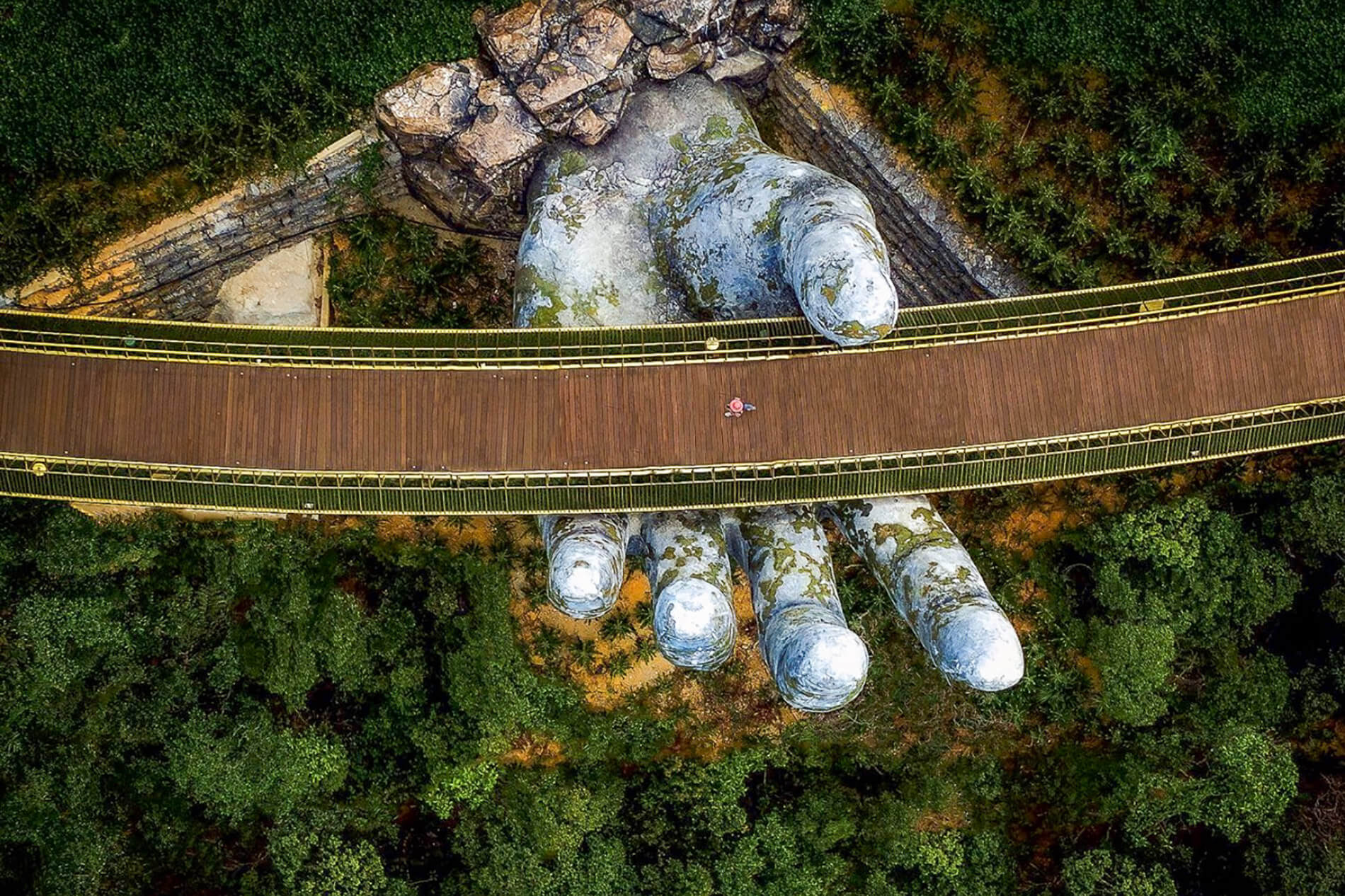

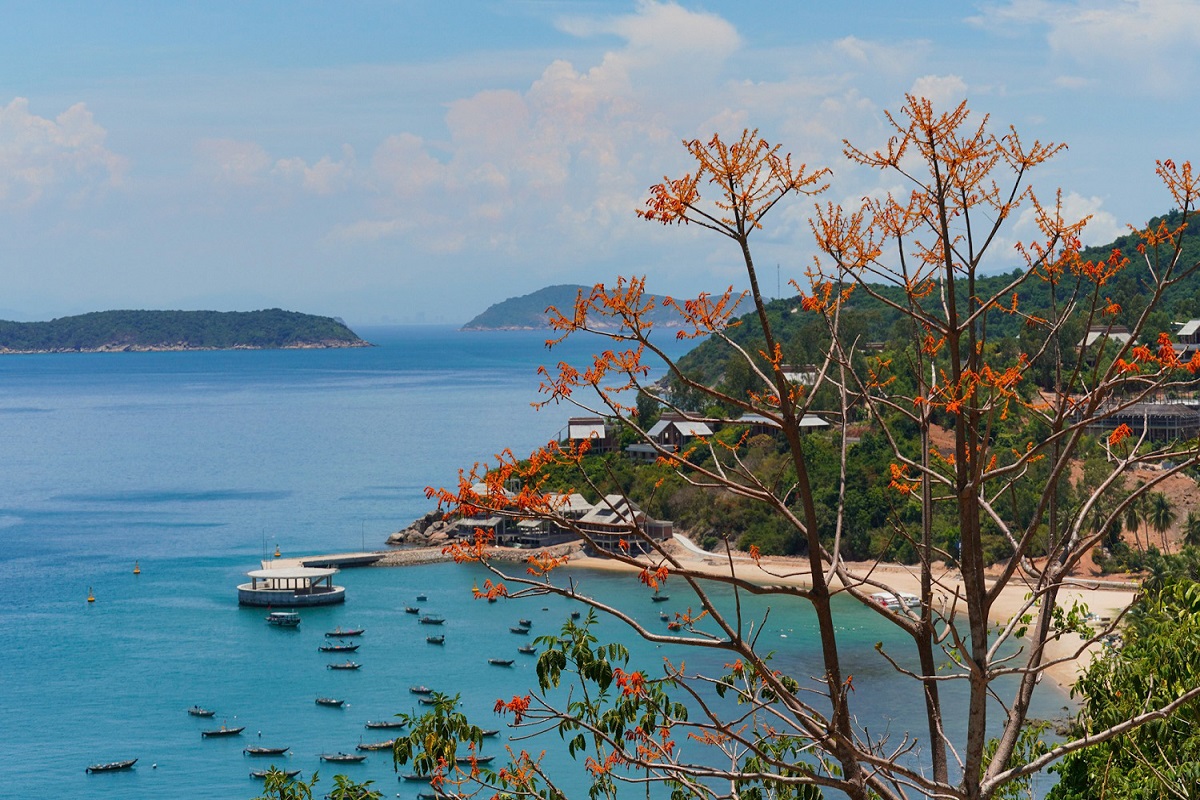






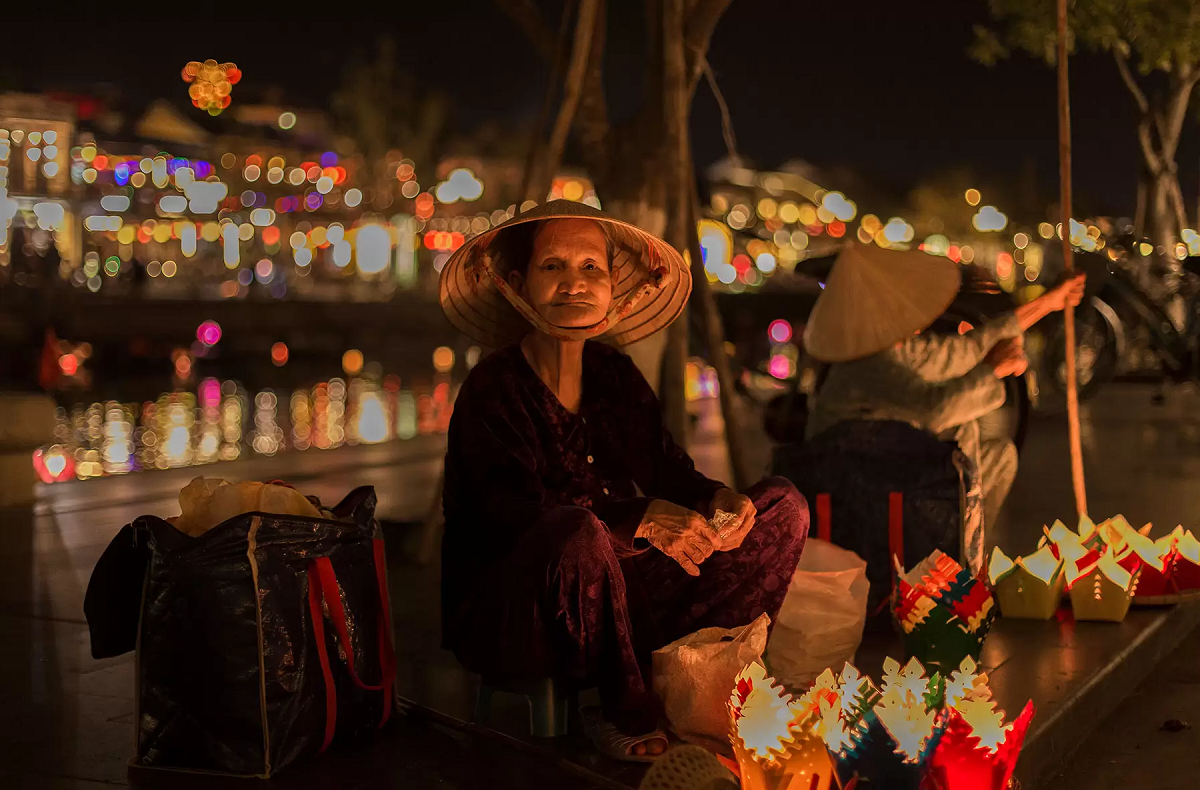

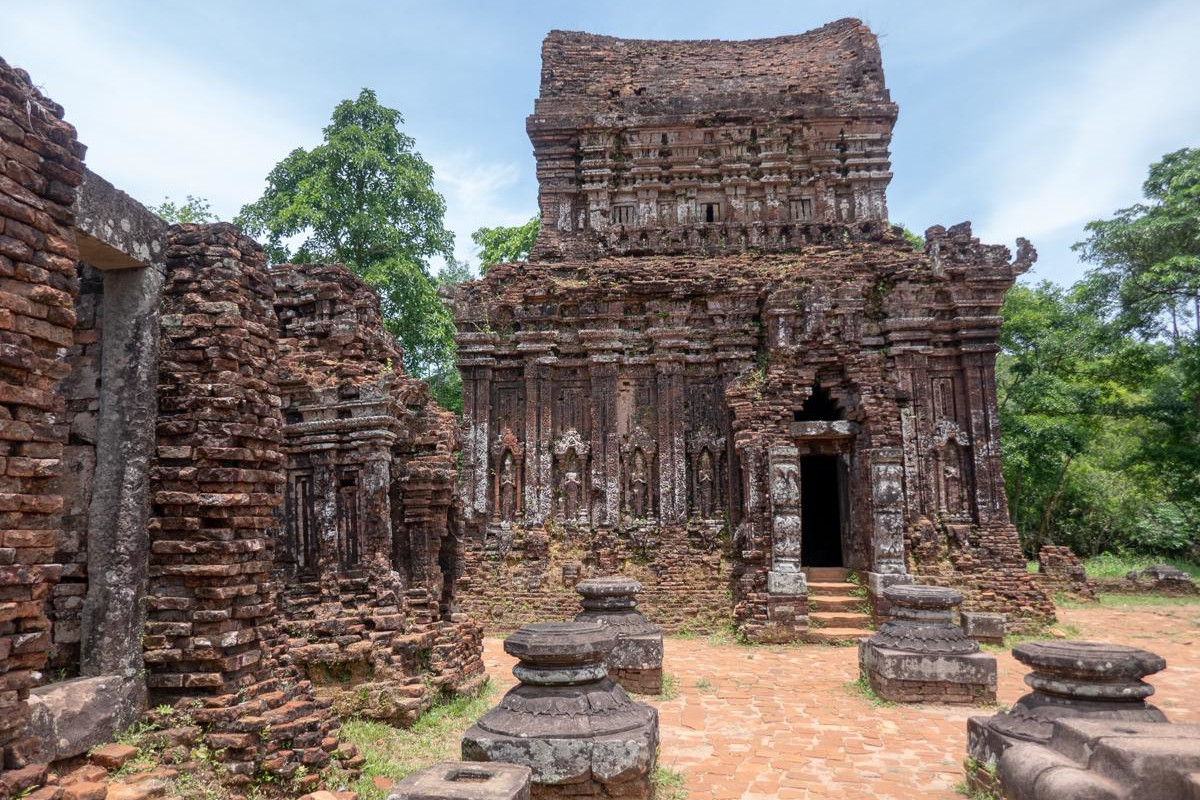

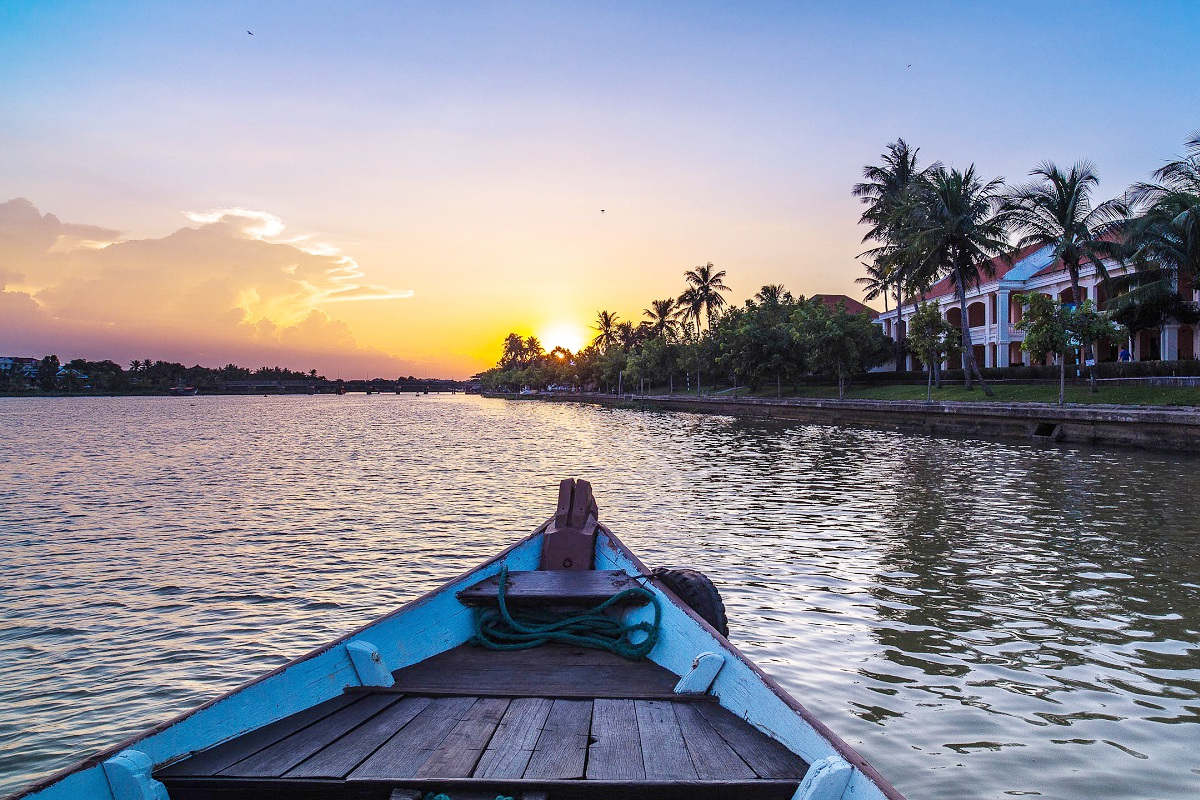





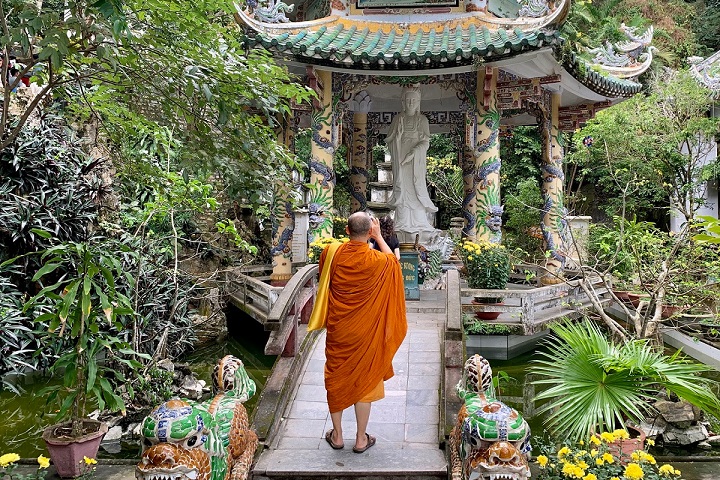












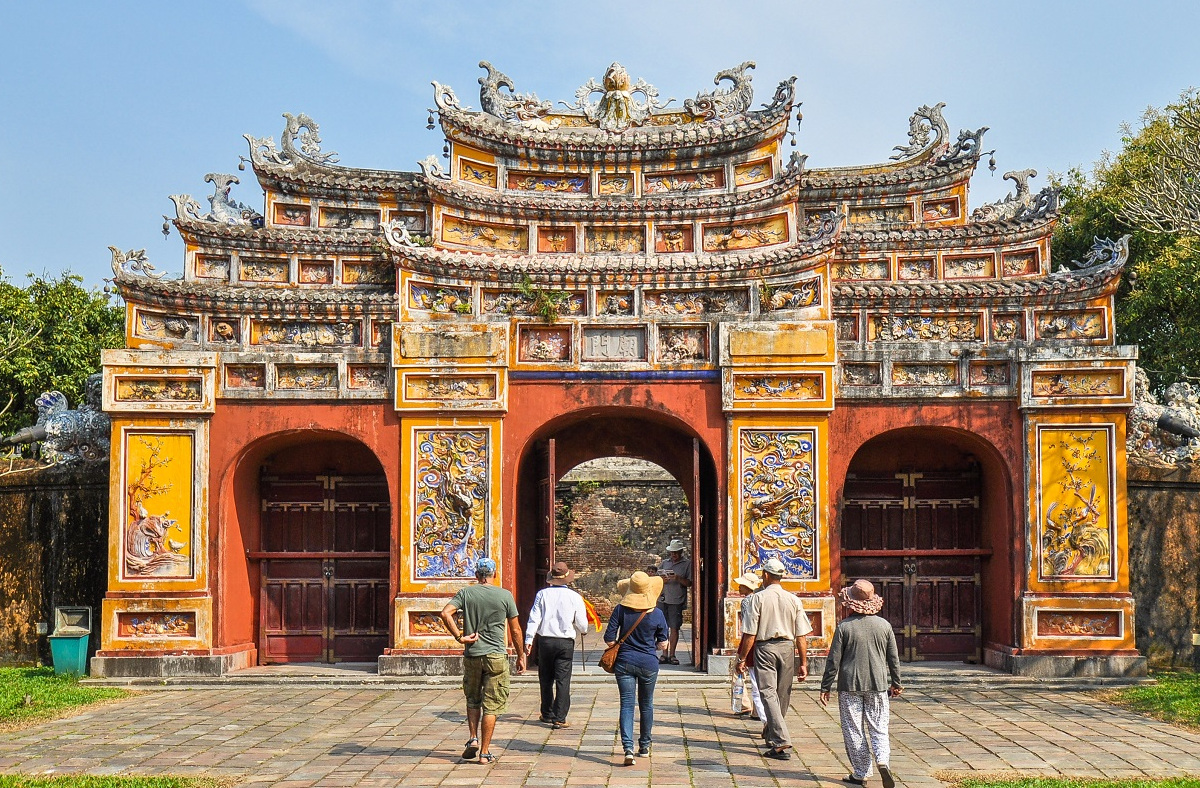








Leave a Reply